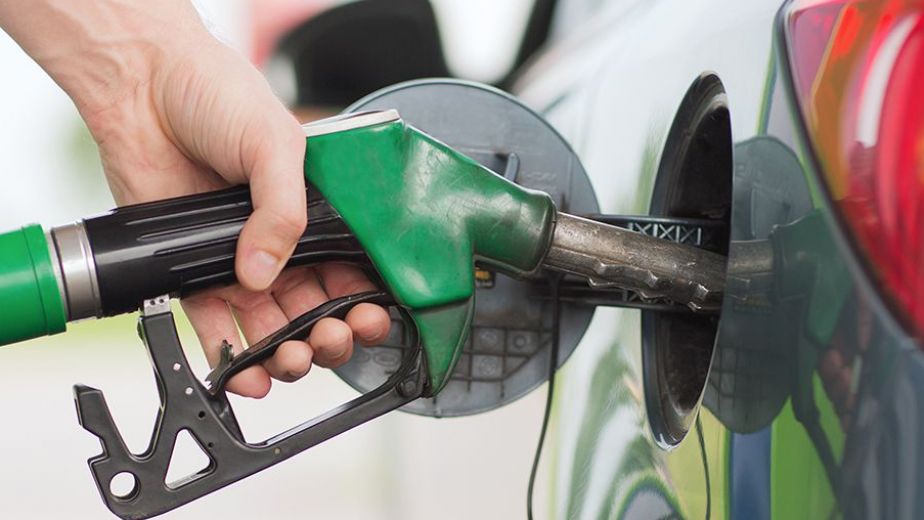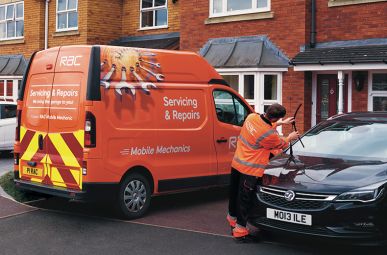To help drivers save money filling up, together with the Energy Saving Trust, we’ve compiled the ultimate guide to economical driving. Sometimes known as 'hypermiling' or eco-driving, this will help you to increase your all-important miles per gallon (mpg) figure.
While the speed you drive at is arguably the most influential factor affecting fuel consumption, there are a number of other ways you can change your driving habits that will have a significant impact on the money you spend at the pump.
8 petrol and diesel saving tips
1. Make sure you maintain your vehicle
Regular maintenance and servicing improves the efficiency of your vehicle, and therefore can improve your fuel consumption. Getting your car serviced regularly is advised, and a RAC Mobile Mechanic can help, or search for one of our RAC Approved Garages.
It’s particularly important to make sure your tyres are inflated to the correct pressure as indicated in your owner’s manual as underinflated and overinflated tyres both adversely affect fuel economy. Tyre pressures will vary depending on the load you are carrying: if you have four passengers and luggage then you will need your tyres inflated to the maximum recommended pressures.
Below is a short video on important maintenance checks you should regularly carry out.
2. Gentle right foot: highest gear possible within the speed limit
Excessive speed is the biggest fuel-guzzling factor so having a light right foot and ensuring all acceleration is gentle is very important to fuel-efficient driving.
Of course you will always have to accelerate a number of times on a journey, but that doesn't mean you have to pull away like you're on the starting line at Silverstone!
Probably the biggest secret to achieving high mpg is driving in the highest possible gear for your vehicle while keeping within the speed limit. The best advice in urban areas is to change up through the gears as quickly as you can with the lowest revs possible, probably at around 2000rpm. Remember: the faster an engine spins, the more fuel it uses.
This optimum fuel economy speed will be different for every car, but when the RAC completed its Record Road Trip in the Audi A6 ultra, that particular car’s optimum fuel economy speed was 52mph in seventh gear on the flat.
While there is an ideal speed, road conditions and gradients don’t often allow you to do that speed so you have to improvise and learn to adjust your driving according to the road ahead, a technique often referred to as hypermiling.
Generally speaking, there is no one driving speed which is optimum for fuel economy.
Over the years the speed of 56mph has often been talked about as being the optimum speed. This was due to the old fuel consumption test being run at three speeds: urban, 56mph and 75mph – and 56mph was always, unsurprisingly, the most efficient of these. Typically, cars are most efficient at 45-50mph.
As well as fuel economy differing from vehicle to vehicle, it is also dependent on a number of other factors such as tyre pressure, presence of roof racks, and driving style – all of which are covered in this guide.
Service, repair or MOT?
You can trust the RAC with our local approved garages and NEW mobile mechanics.


3. Anticipate: try not to lose momentum
In line with the above point, keeping the car moving at the right speed is essential to fuel economy. Obviously, this depends on traffic conditions and what’s happening on the road ahead, but slowing down and having to accelerate again naturally uses more fuel.
The best advice is to drive as smoothly as possible, gently using the steering, accelerator and brakes. When slowing down, it’s important to remain in gear as the fuel cut-off switch in a fuel injection engine is then activated, meaning virtually no fuel is used while braking.
Try to anticipate what’s going to happen in front of you by looking well ahead. This way you’ll see the traffic lights on red meaning you can ease back on the accelerator or slow down naturally and potentially keep moving as opposed to coming to a stop.
Driving up hills destroys fuel economy. When you spot a hill coming try to accelerate a little before you reach it, then ease off as you drive up. The extra momentum should be enough to minimise additional fuel consumption.
4. Does cruise control use more fuel?
Cruise control only aids fuel economy when driving on a constant flat surface, hence why it is usually best reserved for motorway driving.
One of the keys to saving fuel is driving at a constant speed, cruise control can do this effectively on flat surfaces, making your driving as fuel efficient as possible by negating unnecessary acceleration.
However, if you were to use your cruise control regularly, not on flat roads, you would encounter problems that would increase your fuel consumption.
This is because your cruise control would be slower to react to gradient changes, meaning when reaching the brow of a hill – at which point you would normally take your foot off the accelerator to maintain more of a constant speed when descending – your cruise control will keep the power on for a little longer as it’s unable to see the gradient change in front of you. Driving in this way regularly would lead to worse fuel consumption.
Interestingly, the most fuel-efficient roads in the country are not quiet extra-urban dual carriageways or 20mph city streets, they are motorways. This is where you can leave the car in top gear and gently cruise along, using minimal fuel.
- Speed cameras – how they work
- Speed limits in the UK: know the laws
- Driving on country roads – the ultimate guide
5. Don’t get dragged down
Don’t leave your roof bars and roof box on because they create wind resistance and cause your car to use more fuel through the ‘drag’ effect. This is increased the faster you drive.
According to the Energy Saving Trust an empty roof rack adds 16% drag when driving at 75mph. At the same speed a roof box adds 39%, making your vehicle much less fuel efficient.
Even those little flags you can affix to your vehicle to show support for your football team during the world cup can decrease your mpg!
Driving with an open window also has a similar effect.
6. Does the AC and heat use fuel?
Yes, it does. Don’t use your air conditioning unless you really have to as it uses engine power and therefore increases fuel consumption.
This goes for heat as well as cooling, so try to dress for the weather, even inside your car, if fuel efficiency is a big concern.
7. Combine journeys: a warm engine is more efficient
Consider making one round trip rather than several short trips. Once the engine is warm it will operate at its most efficient whereas several cold starts will increase fuel consumption even though the total mileage could be the same
This is why the RAC’s Record Road Trip team kept going almost continuously, only stopping for 20 minutes at a time on the way to setting a world record of driving through 14 countries on one tank of fuel. That was 1,158.9 miles, driving at an average speed of 45mph and achieving an incredible 75.9mpg.
Visit the RAC Route Planner to help plan your journey in a more fuel-efficient way.
8. Lighten the load
While this isn’t going to make the biggest difference to your mpg figures it stands to reason that the heavier a vehicle is, the more fuel it will use.
For that reason, don’t keep unnecessary items in your boot as they all add weight to your vehicle, which is not going to help your fuel economy in the long run.
What is hypermiling?
In light of fuel cost increases, the technique of hypermiling has been gaining popularity as fuel economy best practice.
Whilst it's got a flashy name, simply following the tips above will save you money on fuel, so don't worry too much about sticking to a specific hypermiling regimen.
What the experts say
Professional racing driver Rebecca Jackson and motoring journalist Andrew Frankel broke a world record for the most countries visited on a single tank of fuel, so they know a thing or two about how to drive economically. Below is their expert advice.
Rebecca Jackson’s advice
"To set any kind of fuel efficiency world record you have to be looking ahead as much as possible to pre-empt oncoming hazards. This is a good general driving habit but it was absolutely crucial for us.
"It’s all about keeping moving and not losing momentum. Accelerating from being stopped is very costly in fuel consumption terms and so is going up any steep incline.
"We tried not to use the brakes as much by easing off the throttle to reduce speed. If you can keep moving slowly rather than stopping in traffic that’s good, but you do have to be conscious of not being a pain to other drivers by leaving too much of a gap behind the car in front.
"You need to listen to the engine to make sure you don’t use excessive revs but you need to use enough, so it’s a fine balance as you don’t want the car to be labouring too much either."
Andrew Frankel’s advice
"If you are coming up to a roundabout you need to know whether you will be able to get through without slowing down too much by adjusting your speed very carefully before you enter.
"And, if you have a hill coming up you need to judge not just the gradient, but its likely duration too. If you can see it’s just a short rise it’s better to coast up, lose the speed and stay in gear rather than change down early. Each hill is therefore different and there is of course an element of guesswork."
Watch the full record-breaking road trip video here:
It’s particularly important to make sure your tyres are inflated to the correct pressure as indicated in your owner’s manual as underinflated and overinflated tyres both adversely affect fuel economy.













